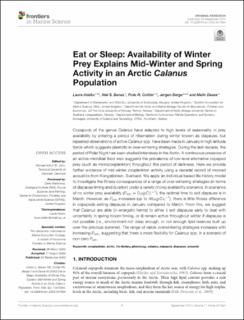| dc.contributor.author | Hobbs, Laura | |
| dc.contributor.author | Banas, Neil S. | |
| dc.contributor.author | Cottier, Finlo Robert | |
| dc.contributor.author | Berge, Jørgen | |
| dc.contributor.author | Daase, Malin | |
| dc.date.accessioned | 2021-02-23T12:26:19Z | |
| dc.date.available | 2021-02-23T12:26:19Z | |
| dc.date.created | 2021-01-29T14:59:36Z | |
| dc.date.issued | 2020 | |
| dc.identifier.citation | Frontiers in Marine Science. 2020, 7 . | en_US |
| dc.identifier.issn | 2296-7745 | |
| dc.identifier.uri | https://hdl.handle.net/11250/2729797 | |
| dc.description.abstract | Copepods of the genus Calanus have adapted to high levels of seasonality in prey availability by entering a period of hibernation during winter known as diapause, but repeated observations of active Calanus spp. have been made in January in high latitude fjords which suggests plasticity in over-wintering strategies. During the last decade, the period of Polar Night has been studied intensively in the Arctic. A continuous presence of an active microbial food web suggests the prevalence of low-level alternative copepod prey (such as microzooplankton) throughout this period of darkness. Here we provide further evidence of mid-winter zooplankton activity using a decadal record of moored acoustics from Kongsfjorden, Svalbard. We apply an individual based life-history model to investigate the fitness consequences of a range of over-wintering strategies (in terms of diapause timing and duration) under a variety of prey availability scenarios. In scenarios of no winter prey availability (Pwin=0μgCL−1), the optimal time to exit diapause is in March. However, as Pwin increases (up to 40μgCL−1), there is little fitness difference in copepods exiting diapause in January compared to March. From this, we suggest that Calanus are able (in energetic terms) to either i) exit diapause early to deal with uncertainty in spring bloom timing, or ii) remain active throughout winter if diapause is not possible (i.e., environment not deep enough, or not enough lipid reserves built up over the previous summer). The range of viable overwintering strategies increases with increasing Pwin, suggesting that there is more flexibility for Calanus spp. in a scenario of non-zero Pwin. | en_US |
| dc.language.iso | eng | en_US |
| dc.publisher | Frontiers | en_US |
| dc.rights | Navngivelse 4.0 Internasjonal | * |
| dc.rights.uri | http://creativecommons.org/licenses/by/4.0/deed.no | * |
| dc.title | Eat or sleep: Availability of winter prey explains mid-winter and spring activity in an Arctic Calanus population | en_US |
| dc.type | Peer reviewed | en_US |
| dc.type | Journal article | en_US |
| dc.description.version | publishedVersion | en_US |
| dc.source.pagenumber | 14 | en_US |
| dc.source.volume | 7 | en_US |
| dc.source.journal | Frontiers in Marine Science | en_US |
| dc.identifier.doi | 10.3389/fmars.2020.541564 | |
| dc.identifier.cristin | 1882653 | |
| dc.description.localcode | Copyright © 2020 Hobbs, Banas, Cottier, Berge and Daase. This is an open-access article distributed under the terms of the Creative Commons Attribution License (CC BY). The use, distribution or reproduction in other forums is permitted, provided the original author(s) and the copyright owner(s) are credited and that the original publication in this journal is cited, in accordance with accepted academic practice. No use, distribution or reproduction is permitted which does not comply with these terms. | en_US |
| cristin.ispublished | true | |
| cristin.fulltext | original | |
| cristin.qualitycode | 1 | |

